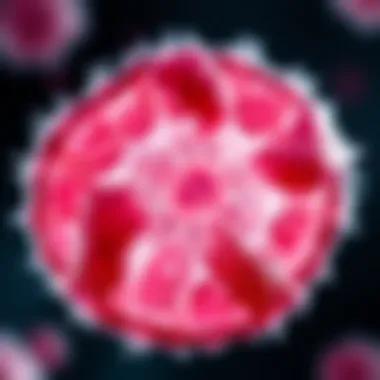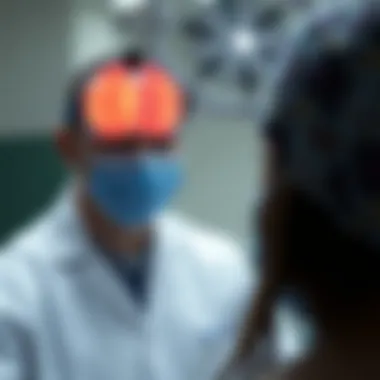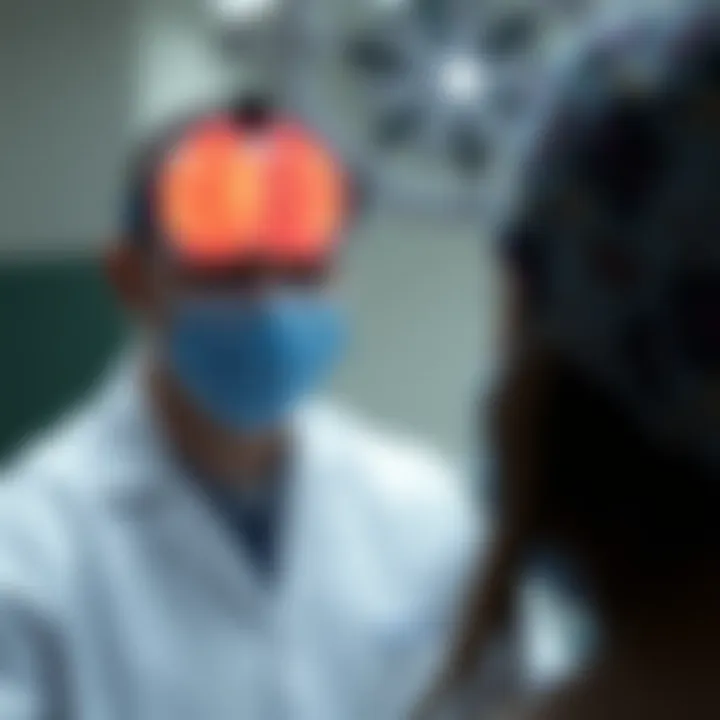Understanding the Spread of Squamous Cell Carcinoma


Intro
Squamous cell carcinoma (SCC) is more than just a term tossed around in medical circles; it represents a significant challenge that professionals encounter in oncology. This form of skin cancer finds its roots in the squamous cells, which are flat cells located on the surface of the skin as well as in some mucous membranes. While many may view SCC as a localized disease with relatively straightforward treatment options, the reality is more nuanced, as this cancer possesses an uncanny ability to spread, or metastasize, to other areas in the body. This article dives deep into understanding SCC, focusing on its potential for metastasis, and aims to enlighten both budding medical students and seasoned professionals alike.
Research Overview
Summary of Key Findings
Research on squamous cell carcinoma reveals several critical insights:
- Metastasis Rates: SCC commonly spreads to lymph nodes, lungs, and other organs, particularly if diagnosed late. The risk of metastasis grows significantly with tumor size, depth, and location.
- Biological Characteristics: Certain genetic mutations, such as those in the TP53 gene, are prominent in SCC and are believed to play a role in its aggressive behavior.
- Diagnostic Techniques: Early detection through tools like dermoscopy can substantially improve outcomes, yet many cases still go undiagnosed until they reach an advanced stage.
Background and Context
Historically, squamous cell carcinoma has been overshadowed by its more famous counterpart, melanoma. However, it is vital to note that SCC represents one of the most prevalent skin cancers worldwide. Factors such as sun exposure, immunosuppression, and chronic inflammation all contribute to the evolving landscape of SCC pathology.
Awareness is crucial, especially among at-risk populations, including fair-skinned individuals and those with a history of tanning bed use. As awareness grows, so does the need for structured methodologies that not only aim at treatment but also prioritize prevention and early diagnosis.
"Understanding the intricacies of SCC is not just for the oncologist; it's for everyone invested in healthcare—a vital piece to the cancer puzzle."
Methodology
Experimental Design
Effective research on SCC metastasis often employs a blend of clinical studies and laboratory experiments. Clinical cohorts of patients with various stages of SCC provide a rich ground for gathering real-world data. In the lab, animal models of SCC are invaluable, allowing researchers to observe tumor behavior and response to treatments in a controlled setting.
Data Collection Techniques
Data collection revolves around multiple avenues:
- Biopsy Results: Analysis of tissue samples forms the backbone of understanding tumor characteristics.
- Patient Questionnaires: Gathering patient history related to lifestyle, sun exposure, and risk factors helps to create a clearer picture of SCC's prevalence.
- Radiographic Imaging: Techniques such as MRI and CT scans are pivotal in assessing the extent of metastasis and planning targeted therapies.
This structured approach offers a comprehensive look into SCC, enabling the medical community to better understand the factors that contribute to its spread and to better tailor treatment options for patients.
Intro to Squamous Cell Carcinoma
Understanding squamous cell carcinoma (SCC) goes beyond mere terminology; it's about grasping a significant health issue that affects countless individuals. This type of skin cancer, while common, harbors depths of complexity that make awareness and understanding vital for both patients and healthcare professionals alike. This section aims to shed light on the multifaceted nature of SCC, offering insights into its characteristics, behaviors, and the implications for treatment and prognosis.
SCC serves as a vivid example of how one type of cancer can lead to diverse clinical presentations and outcomes. The key factors influencing its progression are interconnected, weaving through biological, environmental, and genetic landscapes. Being informed about these elements helps in early detection and improves treatment strategies. Moreover, understanding SCC can aid in dispelling common misconceptions that may deter individuals from seeking necessary medical advice.
Overview of Skin Cancers
In order to appreciate the specifics of squamous cell carcinoma, it’s essential to broaden the lens and consider the wider category of skin cancers. Skin cancer is generally categorized into three primary types: basal cell carcinoma, squamous cell carcinoma, and melanoma. Among these, SCC is notable for its potential to metastasize, unlike its counterpart, basal cell carcinoma, which rarely spreads beyond its origin.
According to the Skin Cancer Foundation, skin cancers account for more cases than any other type of cancer in the U.S. Factors such as prolonged sun exposure, tanning beds, and some medical conditions elevate the risk for developing skin cancers in general. Recognizing these risk factors plays a crucial role in prevention, early detection, and, consequently, a better chance of effective treatment.
Defining Squamous Cell Carcinoma
So, what exactly is squamous cell carcinoma? In simple terms, SCC arises from the squamous cells, which are flat cells located on the surface of the skin, as well as lining some internal organs. When these squamous cells mutate, they can grow abnormally, leading to a malignancy called squamous cell carcinoma. It often appears in areas frequently exposed to UV radiation such as the face, neck, and scalp. However, it isn’t confined to these regions and can manifest in other parts of the body.
The prognosis for SCC varies significantly based on a range of factors including the size, depth, and location of the tumor, as well as how early it is detected. For a more robust understanding, consider the following key points about SCC:
- Common Symptoms: These may include red patches, open sores, or elevated growths with a scaly surface. Being vigilant about such symptoms can lead to timely medical consultations.
- Prevalence: It's among the most frequently diagnosed skin cancers, with thousands of new cases emerging yearly.
- Treatment Trends: The approach to treating SCC depends greatly on its stage and specific characteristics, ranging from topical treatments to advanced surgeries.
"Understanding squamous cell carcinoma is not just about knowing the medical terminology; it is about recognizing the implications for patients and finding ways to provide effective care."
The next sections will delve deeper into the biology, risk factors, diagnostics, and treatment strategies surrounding SCC. Each aspect contributes to the broader understanding of how this cancer spreads and how we can better manage it.
The Biology of Squamous Cell Carcinoma
Understanding the biology of squamous cell carcinoma (SCC) is essential for several reasons. First, it provides insight into how SCC originates, develops and spreads within the body. This knowledge can lead to more effective diagnosis, treatment, and management strategies, ultimately improving patient outcomes. Furthermore, grasping the molecular underpinnings of SCC's behaviour gives healthcare professionals and researchers the tools they need to design targeted therapies, which could change the landscape of cancer treatment.
Cellular Origin and Development
SCC primarily arises from the squamous cells found in the skin and mucous membranes, which are often the body's first line of defence against environmental assaults, be it UV radiation or pathogens. These cells undergo a complex process of change, starting from normal squamous epithelium to hyperplasia, and eventually to carcinoma in situ before becoming invasive. In fact, many of the early stages can occur without noticeable symptoms, which complicates early detection.
The nurturing ground for SCC often lies in areas exposed to chronic irritation or ultraviolet light. A noteworthy example includes sunburned skin, where the cells may accumulate mutations over time. Likewise, precursors to SCC, such as actinic keratosis, can signpost future tumor development.
In simple terms, the environment a cell swims in, paired with its lineage, can lead it down the path of cancerous change. The transition from normalcy to malignancy is often dictated by a series of cumulative insults—both genetic and environmental—that create a perfect storm for invasive growth.
"Understanding how cells evolve from benign states to aggressive ones is crucial for intervening before malignancy takes hold."


Molecular Mechanisms of Carcinogenesis
At the molecular level, squamous cell carcinoma gives us a lesson in the intricate dance of genes and proteins. Alterations in specific genes, which are crucial regulators of cellular processes, can lead to uncontrolled growth and division. Key players in this narrative include oncogenes and tumor suppressor genes.
For example, mutations in the TP53 gene, often dubbed the "guardian of the genome," can compromise a cell's ability to repair DNA or undergo apoptosis, allowing it to evolve into a malignant state. Similarly, the activation of oncogenes like RAS may drive this aggressive behaviour further.
In addition to genetic mutations, epigenetic changes also play a role in SCC development. These modifications can affect gene expression without altering the underlying DNA sequence, leading to a situation where susceptible cells don't behave as they should, thus fostering malignancy.
Furthermore, the interaction of these molecular players with the tumor microenvironment is not to be underestimated. Factors such as inflammation, immune responses, and surrounding support cells create a dynamic atmosphere that can promote tumor growth or inhibit it. The balance between these influences is delicate and often tipped in favour of malignancy in cases of SCC.
In sum, the biology of squamous cell carcinoma is a tale of transformation, driven by a blend of genetic predispositions and environmental factors. A thorough grasp of these biological principles enables both researchers and practitioners to better navigate the challenging waters of cancer treatment and prevention.
Risk Factors for Squamous Cell Carcinoma
Understanding the risk factors associated with squamous cell carcinoma (SCC) is crucial for developing effective prevention strategies and improving patient outcomes. By identifying the elements that elevate the likelihood of developing SCC, healthcare providers can better educate patients on protective measures, surveillance, and prompt intervention when necessary. This section delves into two primary categories: environmental influences and genetic predispositions, which play significant roles in the etiology of this cancer.
Environmental Influences
A variety of external factors can heighten the risk of developing squamous cell carcinoma. These influences typically stem from exposure to harmful agents or environments. One of the most notorious culprits is ultraviolet (UV) radiation from sunlight. Prolonged exposure to the sun, particularly during peak hours when UV rays are strongest, leads to skin damage that can eventually trigger malignant transformations in squamous cells.
Consider the case of outdoor workers, like construction laborers or farmers, who spend significant amounts of time under the sun without adequate protection. Over the years, the cumulative effect of UV exposure becomes evident, often resulting in precancerous lesions or, worse, SCC. It's imperative for individuals in such occupations to adopt sun safety practices, like using broad-spectrum sunscreen, wearing protective clothing, and seeking shade whenever possible.
Besides UV radiation, other environmental factors include:
- Tobacco Smoke: Both smoking and exposure to secondhand smoke are linked to an increased risk of SCC, particularly in the oral cavity and throat.
- Chronic Inflammation: Conditions like ulcerative colitis or chronic infections can create a conducive environment for cancer development.
- Chemical Exposures: Occupational exposure to substances such as arsenic, coal tar, and certain petroleum products has been associated with elevated SCC risk.
Through diligence and awareness, individuals can minimize exposure to these environmental risk factors, significantly lowering their chances of developing SCC.
Genetic Predispositions
Genetics also plays a pivotal role in the likelihood of developing squamous cell carcinoma. Understanding one's genetic predisposition can provide insights into personal risk factors, even in the absence of environmental triggers. Certain genetic conditions can increase vulnerability to SCC, particularly those affecting skin health or immune response.
Take, for instance, xeroderma pigmentosum (XP), a rare genetic disorder characterized by extreme sensitivity to UV light. Individuals with XP have a drastically increased risk of developing skin malignancies, including SCC, due to their bodies' inability to effectively repair UV-induced DNA damage. Similarly, those with a family history of skin cancers should be vigilant about skin examinations and protective measures.
Other notable genetic considerations include:
- Inherited Mutations: Variations in genes such as TP53 or CDKN2A can significantly escalate skin cancer risks.
- Skin Type and Pigmentation: Fair-skinned individuals, who have less melanin, typically face higher risks because melanin provides some protection against UV damage.
Awareness of genetic risk factors can empower individuals and caregivers, prompting them to take preventive action and seek regular skin evaluations.
Diagnosis of Squamous Cell Carcinoma
Accurate diagnosis of squamous cell carcinoma (SCC) is critical in managing patient care and treatment decisions. Early detection can significantly impact treatment outcomes, reducing the risk of complications from metastasis. As SCC can mimic other skin conditions, the diagnostic process must be thorough and multi-faceted. Let's dive into the core components of this diagnosis: clinical presentation and symptoms, diagnostic imaging techniques, and histopathological examination.
Clinical Presentation and Symptoms
The clinical presentation of SCC typically starts with subtle skin changes, which can include:
- Persistent red patches or scaly lesions that may be itchy or painful
- Non-healing sores that fail to improve over time
- Elevated growths, often with a central depression
- Ulcerations that bleed or crust over
Patients may notice these symptoms on sun-exposed areas, like the face, ears, neck, or hands. However, the lesions can also appear on less visible sites. Especially in the early stages, symptoms are often mild, causing individuals to delay seeking medical attention.
A good medical history is vital. Patients should discuss any changes in existing lesions or the emergence of new skin growths. Moreover, a family history of skin cancers or personal history of skin disorders may further aid in the diagnostic process.
"Early diagnosis can be the difference between a simple treatment and extensive interventions."
Diagnostic Imaging Techniques
While clinical evaluation is fundamental, imaging studies play a significant role when assessing the extent of SCC. Diagnostic imaging helps determine if cancer has invaded deeper tissues or nearby lymph nodes. Commonly used techniques include:
- Ultrasound: Provides detailed images of the skin and underlying structures.
- CT scans: Useful for evaluating larger tumors or tracking spread to lymph nodes.
- MRI: Particularly effective for examining lesions with potential neurological implications.
Each of these techniques offers unique insights and assists in planning future treatment strategies. They can confirm the diagnosis and help gauge the aggressiveness of the cancer. It's essential for healthcare providers to make informed decisions based on these findings, ensuring patients receive appropriate interventions promptly.
Histopathological Examination
The gold standard for diagnosing SCC is histopathological examination. This process involves taking a biopsy of the suspicious lesion and examining the tissue under a microscope. Pathologists look for characteristic features, such as atypical keratinocytes and evidence of invasion into surrounding tissues.
A biopsy can be performed in several ways:
- Shave biopsy: A thin slice of tissue is removed for analysis.
- Punch biopsy: A circular tool extracts a deeper core of skin.
- Excisional biopsy: The entire lesion is removed for evaluation.
Histopathology not only confirms the diagnosis but also provides crucial tumor characteristics that influence treatment plans. Information such as tumor differentiation and depth of invasion contributes to staging, which ultimately guides prognosis.


In summary, diagnosing squamous cell carcinoma is a complex and essential process. Each aspect, from recognizing clinical symptoms to using advanced imaging techniques and conducting detailed histopathology, plays a vital role in effective patient management and treatment planning.
Pathways of Metastasis in Squamous Cell Carcinoma
The pathways of metastasis in squamous cell carcinoma are crucial to comprehend when studying this disease. They shed light on how this malignant condition can spread from its original site to distant organs. Understanding these pathways not only aids in early detection and diagnosis but also informs treatment strategies that might minimize the impact of metastasis. By grasping the complexity of SCC's spread, both clinicians and patients can make more informed decisions moving forward.
Local Invasion Mechanisms
At the forefront of SCC's metastasis is local invasion, a process involving the aggressive growth of cancerous cells that break down surrounding tissues. This often occurs when the tumor's biological behavior encourages the development of tumor microenvironments that support rapid differentiation and proliferation.
Key aspects of local invasion mechanisms include:
- Extracellular Matrix (ECM): Tumor cells modify the ECM to facilitate invasion, breaking down collagen structures and altering fibronectin production, which weakens tissue integrity.
- Growth Factors & Cytokines: The secretion of specific growth factors, such as vascular endothelial growth factor (VEGF), plays a pivotal role in promoting angiogenesis, further supporting tumor expansion.
- Cell Adhesion Molecules: The reduction of certain adhesion molecules like E-cadherin allows cancer cells to detach and migrate into nearby tissues, increasing the likelihood of local spread.
"The local invasion of SCC is not merely about the presence of tumors; it involves a full-blown remake of the surrounding landscape and a disturbance of the normal cellular community."
Local invasion significantly complicates treatment, making it essential for healthcare providers to remain vigilant in monitoring high-risk individuals.
Lymphatic Spread
Lymphatic spread occurs when SCC spreads through the lymphatic system, often beginning when cancer cells penetrate lymphatic vessels. This method can allow for the dissemination of cancerous cells to regional lymph nodes, which might indicate a more aggressive disease.
Factors contributing to lymphatic spread include:
- Tumor Location: The anatomical proximity of lymph nodes to the SCC site can heighten the chances of nodal involvement.
- Size of the Tumor: Generally, larger tumors hold a higher propensity for lymphatic spread, resulting in a more advanced stage of cancer.
- Histological Features: Poorly differentiated tumors with increased mitotic activity often show a greater tendency to metastasize via lymphatics.
Accurate staging and understanding how lymphatic pathways interact with cancer cells may be critical in establishing targeted therapies aimed at controlling metastasis.
Hematogenous Metastasis
Hematogenous metastasis is another significant pathway through which squamous cell carcinoma can spread, involving the bloodstream as a conduit. This form of metastasis can potentially lead to distant organ involvement, making it a daunting aspect to manage.
Key points regarding hematogenous spread include:
- Circulation of Tumor Cells: Once SCC cells enter the circulation, they must evade immune surveillance and establish survival in the bloodstream, a daunting task.
- Tropism to Specific Organs: Certain types of SCC display a peculiar affinity to organs such as the lungs or liver, theorized to be due to organ-specific receptors allowing for better establishment of metastatic colonies.
- Tumor Microenvironment: The capability of SCC to thrive in the distant microenvironments also plays a critical role in successful metastasis, affecting treatment response.
Understanding these nuances of hematogenous metastasis provides invaluable insights for creating systemic treatments aimed at preventing further spread of the disease.
In summary, recognizing these pathways is fundamental in tailoring effective treatment strategies for squamous cell carcinoma, necessitating continual research and clinical vigilance.
Prognosis of Squamous Cell Carcinoma
Understanding the prognosis of squamous cell carcinoma (SCC) is vital for both patients and healthcare providers. This aspect provides insights into how the disease might progress, guiding treatment decisions and patient management. Knowing the likely course of the disease can greatly influence the emotional and psychological states of patients as they navigate their healthcare journey. Just as importantly, it informs the medical team on how to tailor interventions suitably to improve outcomes.
Staging Systems and Their Relevance
Staging systems are crucial in determining the prognosis of SCC. Generally, tumor staging divides cancer into stages based on the tumor's size, location, and extent of spread. In the context of SCC, the AJCC (American Joint Committee on Cancer) system is commonly used. It categorizes tumors from stage 0, which indicates a carcinoma in situ, to stage IV, reflecting advanced disease with significant metastasis.
- Stage 0: Carcinoma in situ, localized and not invasive.
- Stage I: Tumor is small and localized, typically under 2 cm.
- Stage II: Tumor is larger and may have spread to nearby tissues or lymph nodes.
- Stage III: Tumor has significantly advanced and spreads to regional lymph nodes.
- Stage IV: Involves distant metastasis, where the cancer has spread to other organs.
The importance of knowing the stage lies in prognosis. Generally, earlier-stage SCC has a much better outcome than advanced stages. Patients may find comfort in hearing that the survival rate drops sharply once the cancer metastasizes.
Factors Influencing Survival Rates
Survival rates for SCC depend on several key factors. Each plays a role in how treatment is approached and can either enhance or inhibit patient outcomes. Here are some key elements:
- Tumor Thickness and Depth: Thicker tumors with deeper invasion into the skin layers correlate with poorer survival rates.
- Location of the Tumor: SCC on the lip or ear tends to have a worse prognosis than similar tumors located on less sun-exposed skin.
- Lymph Node Involvement: If the cancer has spread to lymph nodes, it significantly worsens prognosis.
- Histological Variants: Certain subtypes of SCC may display more aggressive behavior, influencing treatment choices and compassion towards the patient’s condition.
- Patient-Related Factors: Age, immune status, and overall health also play critical roles. Patients with suppressed immune systems, for instance, have worse outcomes.
"For every 1% increase in tumor thickness, the survival rate may decrease by as much as 5%."
Understanding the prognosis of SCC, combined with relevant staging, can empower patients and healthcare providers alike. It provides a foundation for communicating about treatment options and lays the groundwork for effective management. Patients need not only medical facts, but also the reassurance of a plan moving forward.
For further insights and resources, consider visiting the following links:
- American Cancer Society
- National Cancer Institute
- ClinicalTrials.gov
- Mayo Clinic - Squamous Cell Carcinoma
Treatment Strategies for Squamous Cell Carcinoma
The approach to treating squamous cell carcinoma (SCC) is multifaceted and must be tailored to the individual based on several factors including the stage of the disease, location of the tumor, and the patient's overall health. Understanding these strategies is essential not only for clinicians but also for patients and their families as they navigate this serious diagnosis. The various treatment modalities aim to remove or kill cancer cells, prevent further spread, and ultimately improve patient outcomes.
Surgical Intervention
Surgical intervention plays a pivotal role in the management of SCC, especially in its early stages. The goal of surgery is to excise the tumor completely along with a margin of healthy tissue to minimize the chance of recurrence. This technique is often referred to as margins-negative excision or R0 resection in medical terminology. There are different surgical options for SCC:


- Wide Local Excision: This method involves removing the cancerous lesion, along with a surrounding area of healthy skin. It is particularly effective for tumors localized to the skin.
- Mohs Micrographic Surgery: A highly specialized technique, Mohs surgery is performed in stages and allows for immediate microscopic examination of the removed tissue, ensuring complete tumor clearance while sparing healthy skin.
- Lymph Node Dissection: In cases where the cancer has spread to nearby lymph nodes, excising these nodes may be necessary to control the disease and prevent further metastasis.
Surgical techniques present a significant advantage in terms of immediate outcomes; however, they may have varying impacts on the patient's aesthetic and functional recovery, particularly for tumors located on the face or sensitive areas of the body. Hence, discussing these factors with the healthcare team is crucial.
Radiation Therapy Considerations
Radiation therapy is often utilized not only as a primary treatment for SCC but also as an adjunct therapy, especially in patients unsuitable for surgery. This modality uses high-energy rays to target and destroy cancer cells and can be employed in several scenarios:
- Postoperative Radiation: This is given after surgery to reduce the risk of local recurrence, particularly when the surgical margins are close or involved.
- Palliative Radiation: For patients with advanced SCC who may not be surgical candidates, radiation can help alleviate symptoms and improve quality of life.
- Brachytherapy: A form of internal radiation therapy where radioactive seeds are implanted directly at the site of the tumor.
The side effects of radiation can include skin irritation and fatigue, and these considerations are important when devising a treatment plan. Discussions with radiation oncologists typically help in striking a balance between the benefits and potential adverse effects.
Chemotherapeutic Approaches
Chemotherapy for SCC is generally used in advanced stages or when the disease is metastatic. This systemic treatment aims to kill cancer cells that may have spread beyond the original tumor site. The following are pivotal aspects regarding chemotherapy:
- Combination Chemotherapy: Often employs several agents to enhance treatment efficacy. This method can be more effective for aggressive or widespread cancer in lymph nodes.
- Neoadjuvant Chemo: Administering chemotherapy prior to surgery to shrink tumors can lead to better surgical outcomes.
- Side Effects Management: Familiarizing patients with potential side effects such as nausea, immune suppression, and hair loss is essential for maintaining treatment adherence and improving overall quality of life.
While chemotherapy's effectiveness against SCC is variable, it is crucial for patients to engage in comprehensive discussions with their oncologists regarding potential benefits versus risks.
Immunotherapy and Its Efficacy
The advent of immunotherapy marks a notable advancement in the treatment of SCC, particularly for patients with advanced forms of the disease. This approach harnesses the body’s immune system to fight cancer, allowing for a more targeted attack with potentially fewer side effects than traditional therapies. Here are some significant points:
- Checkpoint Inhibitors: Agents such as pembrolizumab and nivolumab block proteins that prevent the immune system from attacking cancer cells. These treatments have shown promise in multiple trials, leading to improved outcomes for some patients.
- Tumor-Infiltrating Lymphocytes (TIL): Another innovative approach involves extracting immune cells from the tumor, expanding them in the lab, and reinfusing them into the patient.
- Evaluation of Effectiveness: Monitoring response to treatment is critical, as not every patient will benefit from immunotherapy. Scans and blood tests help track how well the therapy is working, adjusting the treatment plan as necessary.
As the understanding of the immune response against cancer expands, incorporating immunotherapy could reshape the future landscape of squamous cell carcinoma management, particularly in previously difficult-to-treat cases.
Further information on treatment strategies can be found at American Cancer Society and National Cancer Institute.
Future Directions in Research
Research on squamous cell carcinoma (SCC) is in a constant state of evolution, fueled by the quest for better understanding and treatment of this aggressive cancer. The significance of future directions in research cannot be overstated. These efforts promise to unveil new strategies for early detection and offer novel therapeutic options that can potentially transform patient outcomes. This section focuses on the exciting potential of research into novel therapeutic targets and advancements in early detection strategies.
Novel Therapeutic Targets
The search for innovative therapeutic targets marks a pivotal moment in the treatment of SCC. Currently available therapies, while effective for some, often fall short in preventing recurrence or progression, particularly in cases where the carcinoma has already metastasized. Falling behind the latest findings in molecular biology and genetics can hinder the development of effective new treatments. Researchers are increasingly identifying specific molecular pathways that are integral to the growth and spread of SCC. For instance, targeting the epidermal growth factor receptor (EGFR) has shown promise in clinical trials, suggesting a dual benefit of slowing tumor growth and enhancing the effectiveness of existing treatments.
These targets aren’t limited to just proteins or genes; researchers explore the role of microRNAs and epigenetic factors as well. Each discovery potentially paves the way for personalized medicine—treatments tailored to the unique genetic makeup of an individual's tumor. Such advancements could lead to the development of therapies that not only target the cancer directly but also modulate the tumor microenvironment, enhancing the efficacy of immune responses.
- Benefits of exploring novel therapeutic targets:
- Increased specificity in treatment, reducing side effects.
- Potential for combination therapies that maximize effectiveness.
- Personalization of treatment to individual patient needs.
As new targets enter the spotlight, collaboration between researchers, clinicians, and pharmaceutical companies will play an essential role. These partnerships can facilitate the rapid translation of research findings into clinical applications.
Advancements in Early Detection
Early detection of squamous cell carcinoma significantly improves the chances of successful treatment. As SCC can rapidly progress and metastasize, integrating advanced diagnostic techniques is crucial for timely intervention. Recent advancements focus on employing cutting-edge imaging technologies and molecular diagnostics, which hold the potential to enhance early detection rates.
One promising approach lies in the use of liquid biopsies, which analyze circulating tumor cells and cell-free DNA from blood samples. This minimally invasive technique offers a glimpse into the tumor's genetic landscape without the need for surgical biopsies, allowing for earlier diagnosis and monitoring of treatment responses. Furthermore, improvements in imaging modalities, including high-resolution ultrasound and novel MRI techniques, facilitate the visualization of tumor characteristics, leading to better screening practices.
Considerations for advancing early detection include:
- Streamlining strategies to incorporate liquid biopsy tests into routine practice.
- Training healthcare providers on interpreting advanced imaging results accurately.
- Promoting awareness of SCC risks among patients and healthcare providers to foster proactive screening.
"The sooner SCC is detected, the faster interventions can be implemented, potentially saving lives."
These advancements not only aid in identifying SCC at earlier stages but can also help monitor the progression of the disease over time. Thus, investing in early detection technologies has far-reaching implications, making it a vital area for future research.
The journey ahead for squamous cell carcinoma research is filled with potential. As we chart a course towards innovative treatments and early detection methods, the ultimate aim is to improve survival rates and quality of life for patients affected by this condition.
Epilogue
Recap of Key Points
- Biological Characteristics: SCC originates from squamous cells—a type of epithelial cell. Its growth can quickly become invasive and aggressive if not monitored closely.
- Metastatic Pathways: The pathways of metastasis include local invasion, lymphatic spread, and hematogenous routes, each presenting unique challenges.
- Diagnosis Techniques: Clinical presentations can range widely. Techniques such as imaging and histopathological examination play crucial roles in early detection and assessment.
- Treatment Strategies: Various treatment modalities exist, including surgical options, radiation, and newer interventions like immunotherapy, which show promise.
- Research and Future Directions: Ongoing research aids in identifying novel therapeutic targets and advancing early detection methods, which can potentially improve patient outcomes.
Implications for Clinical Practice
The insights presented in this article have direct implications for clinical practice.
- Enhanced Patient Management: Understanding the spread of SCC aids clinicians in tailoring treatment plans based on the patient’s disease stage and personal risk factors.
- Informed Decision Making: Familiarity with the latest research allows doctors to incorporate cutting-edge therapies into treatment protocols.
- Public Health Awareness: Increased understanding can contribute to better public health strategies, focusing on prevention and early intervention.
Overall, integrating this knowledge into everyday practice fosters a more proactive approach in combating SCC, ultimately improving survival rates and quality of life for patients affected by this cancer.
"An informed clinician not only treats the illness but also empowers the patient."
For additional resources, consider visiting Wikipedia, Britannica, or CDC for comprehensive data on skin cancers.







